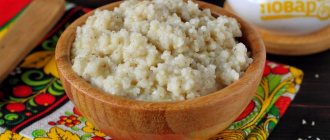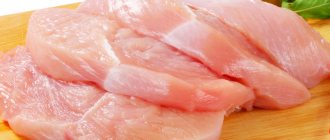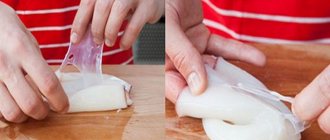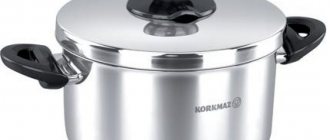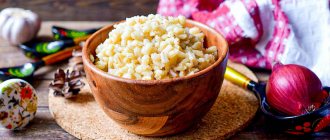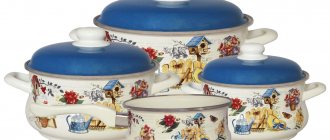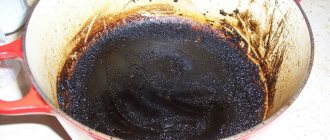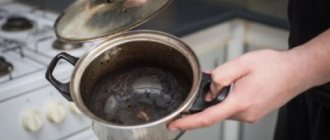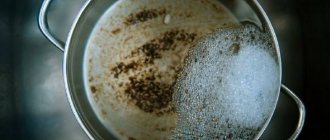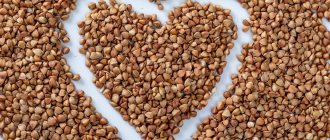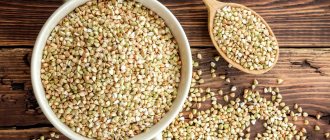Porridge is a universal dish, simple and quick to prepare, an excellent component of nutrition for those losing weight. You can add anything to it, from berries to cheese. But the only negative is the burnt bottom in 2/3 of the cases and, as a result, the routine at the end of the meal: soaking the pan for 20 minutes in hot water, rinsing with an iron sponge, washcloth, etc. However, by following some rules, all this can be avoided .
Why does porridge burn?
It all depends on the dishes. The pan should be Teflon or steel. But over time, the bottom will be scratched and not only the porridge, but also all other dishes will begin to burn.
Read also: Schematic drawing of a bullet and cartridge case
The logical option seems to be purchasing a ceramic pan, BUT! there is still a chance that you will miss the porridge and it will spread all over the stove and you will have to clean both the dishes and the stove.
So what should we do?
Let's figure it out. What do you need to make the perfect porridge?
- She didn't burn. Never ever
- Saves time on cooking
- The dishes were washed once or twice after
- Every morning didn’t turn into a lottery “Will it work out or not?”
Our suggestion is to purchase an inexpensive multicooker. She will cover all the points with interest and then the right breakfast will not take long to arrive.
Just look at the number of functions in this little machine! It stews, boils, and fries, and can be set to heating mode, so that when you come back from a walk, the food remains hot and tasty. Why suffer at the stove every day to cook delicious porridge if a slow cooker will do it for you?
Features of cooking porridge
Many people remember with nostalgia their childhood, where they had delicious “Sadovo” porridge. They try to prepare a dish “like before” and notice with bitterness that it doesn’t work out. Cooking porridge, it turns out, is a whole art, and not least in this process is the choice of suitable utensils.
The pan for crumbly porridge should be thick-walled, with a lid, and a solid bottom. It is advisable to use it strictly for its intended purpose, for preparing this particular dish. For oatmeal and millet (liquid consistency), thin-walled containers (ladles, stewpans) are suitable, but you will have to constantly be at the stove, monitoring and stirring the contents.
Tall pans with a double bottom are suitable for “fast” gas stoves. This way there is less risk that the milk will “run away” when boiling, and the cereal will not burn. For electric stoves and “advanced” glass ceramics, the best choice is ladles and stewpans. The main thing is a flat bottom so that the dishes fit tightly to the hob or burner (spiral).
To ensure that milk porridge never burns, you must follow a number of rules:
- cook the dish in a special container, preferably a thick-walled one;
- stir the contents constantly;
- use absolutely clean containers, without traces of burnt marks, scratches, or chips on the inner walls;
- Correctly calculate the proportions of milk (water) and cereal.
Cereals that do not require simmering during cooking can be cooked in small thin-walled ladles or milk jugs with a volume of 1-1.5 liters.
The pan for simmering porridge should have thick walls, a multi-layer bottom, and a heavy sealed lid. This way the grains cook better, the grains open up well, and the dish turns out delicious.
Types of materials of pots for cooking porridge
Cookware stores offer pots made from a variety of materials: it directly affects the quality of prepared dishes, including porridge.
Stainless steel cookware is loved by many chefs for its durability, resistance to temperature changes, scratches and mechanical damage.
Another clear advantage of stainless steel is its environmental friendliness. In addition, steel models are easy to care for.
When cooking porridge in a stainless steel pan, there is no need to cook the cereal until fully cooked. Thanks to the property of this cookware to retain heat for a long time, the dish will arrive on its own without fire.
The quality of cooking porridge in a stainless steel bowl depends on the thickness of its bottom. The more layers it has, the better. The thinnest aluminum, bronze or copper layers help distribute heat evenly over the entire area of the pan.
Important! Utensils with a bottom thickness of 3 mm, walls more than 0.5 mm and marked 18/10 are considered ideal for preparing porridge. The latter means the ratio of chromium and nickel in the alloy.
The disadvantages of stainless steel cookware include its cost. High-quality models are not cheap. Stainless steel pans require proper care. When cleaning the surface with abrasive substances, scratches remain on it, which further provokes the burning of food.
Thanks to the excellent thermal conductivity of cast iron, porridge in pans made from this material turns out tasty and crumbly. The dish is simmered over low heat, and the flavor of the grains is revealed.
Spelled porridge with parsnips
Photo: Remy Kitchen Bakery Restaurant Recipe by Ruslan Polyakov, chef of the Remy Kitchen Bakery restaurant
- 200 g spelled
- 80 ml milk
- 50 ml cream 11%
- 50 g parsnips
- Salt and sugar to taste
Step 1. Boil the spelled until tender
Step 2. Peel the parsnips and cook until tender (until soft)
Step 3. Then prepare the parsnip puree: mash the finished parsnips with a fork.
Step 4. Place parsnips in a pan with prepared spelled and pour 11% cream and milk
Step 5. Cook until thick. Add salt and sugar to taste. Serve with poppy seed jam.
Pearl barley
Pearl barley contains the amino acid lysine, vitamins B, A, D, E, H and PP, potassium, calcium, zinc, selenium, copper, manganese, iron, iodine, chromium, nickel. Pearl barley helps reduce allergies, fungal skin diseases, and remove toxins from the body.
Method for preparing crumbly pearl barley porridge:
- Take 1 cup of cereal and rinse thoroughly.
- Fry over medium heat in a dry frying pan until a slight nutty smell appears.
- Pour the pearl barley into a colander and rinse with boiling water. This will “seal” the shell of the grain and prevent the porridge from sticking together at the end of cooking.
- Place the cereal in a saucepan and fill it with 3 cups of water, add salt to taste.
- Cook covered over low heat for about 40 minutes. If after a while all the water has not been absorbed, then you need to drain it, throwing the porridge into a colander.
By following the instructions for cooking cereals, you can easily prepare delicious porridge that will not burn or stick together during the cooking process.
Comments for the site
Cackl e
Rice
Rice cereal contains potassium, calcium, magnesium, zinc, selenium, copper, manganese, iron, phosphorus, sodium, as well as vitamins B1, B2, B5, B6, E, H, PP and choline.
Here's how to prepare crumbly rice porridge:
- Pour a glass of rice into a deep container.
- Rinse with water until it becomes clear. The worse the grains are washed, the more they stick together.
- Pour 1 tablespoon into a washed cereal pan and add 2 tablespoons of water. The proportion should always be 1-2, unless the cereal manufacturer indicates otherwise on the packaging.
- Place on the fire, cover with a lid, and bring to a boil.
- Add salt and immediately add butter so as not to stir the boiled rice at the end of cooking, otherwise it will stick.
- Reduce heat to low and simmer for about 15 minutes. The main thing is to catch the moment when all the water is absorbed into the rice and turn off the heat, otherwise the porridge will burn to the ground.
- Remove the pan from the heat, do not open the lid, leave the cereal to sweat for another 5-10 minutes.
How to cook semolina porridge
If you lightly fry the semolina in a frying pan, the porridge will turn out crumbly and very tasty.
1. Bring one liter of milk to a boil, add salt, add sugar, and in a thin stream, to avoid lumps in our porridge, add approximately six tablespoons of cereal.
2. It is important to always be near the pan, since semolina porridge with milk is a big fan of “running away”. Therefore, we watch over it, stirring constantly. Cook the porridge for about five minutes.
3. Now add the butter and remove from the stove, mixing our porridge thoroughly. If this is not done, lumps will appear.
4. Close the lid and let stand for about ten minutes. When serving, you can add oil to the porridge again. This definitely won’t spoil it, and the taste will be amazing. Properly cooked semolina porridge is, according to children, the best porridge in the world.
Milk boiler
For housewives who often prepare milk porridges, a milk boiler will be the best pan. This is a special double pan that prevents milk from escaping .
Operating principle of a milk maker
The milk cooker consists of two containers. There is air space between them. A special hole leads to this space. Water is poured into it before cooking porridge. The hole is equipped with a cover with a built-in whistle. When the water boils, a shrill whistle is heard.
By boiling, the water heats the inner container, into which the milk is then poured. Thus, the porridge is cooked in a water bath. Thanks to this, the dish does not run off or burn.
Reference! Porridge is cooked in a milk cooker as slowly as in a Russian oven. Its taste and appearance are better than those of dishes cooked in ordinary pans.
Which pan should you use to cook milk porridge so it doesn't burn?
Milk porridges are most often prepared liquid. To prepare them, it is better to use deep saucepans made of stainless steel, ceramics or fireproof glass .
Ceramic cookware, like stainless steel cookware, heats up evenly and transfers heat well. It is environmentally friendly and can be used for the stove and oven.
Heat-resistant glass has characteristics similar to ceramics. Porridge does not burn in such dishes. It is easy to clean.
Advice! When using glass and ceramic dishes, sudden temperature changes should not be allowed. If you put a saucepan from their refrigerator on the stove, it will crack.
What you should pay attention to when choosing
A large assortment of saucepans on store shelves makes housewives wonder which one is best suited for cooking porridge. In addition to the material of the pans, there are other characteristics that are worth considering when choosing .
These include:
- the presence of a lid with a convenient handle;
- quality of non-stick coating – titanium and stone are considered the best;
- method of attaching handles - choose dishes with screwed handles rather than welded ones;
- absence of defects - unevenness, scratches, chips;
- brand - give preference to trusted manufacturers Frybest, Bekker, Tescoma;
- Equipped with a measuring scale - in such dishes it is easy to prepare a dish according to any recipe.
If you wash dishes in the dishwasher , before purchasing a pan for cooking porridge, look for a clause in the instructions indicating this option.
From liver to baked goods
When preparing liver, any housewife can make mistakes. For example, dry it out. In this case, this will help: add a little cream sauce to a saucepan with dry liver, bring it to a boil and simmer for fifteen or even twenty minutes.
Even when making regular mashed potatoes, you can overdo it and make it too runny. But what to do if not everyone at home likes this version of the dish? Regular potato starch will come to the rescue, which should be dissolved in milk or chicken broth. Excess liquid evaporates over low heat in a non-stick pan.
It’s not always possible to guess with baking either. It happens that even for those housewives who often bake pies and cakes, the delicacies stick to the pan. How to save dessert without damaging it? Perhaps this is absolutely impossible.
It turns out that this is not the case. You need to lower the form into warm water. And then wrap it in a cold towel. Different temperatures will have a positive effect on baked goods.
Only on a soft spot: Russian Domostroy forbade punishing children in any other way
A broken nail is no problem: tips for treating nails at home
The star of the series “Sultan of My Heart” spoke about the choice of his future wife
Liquid puree
While preparing mashed potatoes, you may accidentally add more water or milk than required. And you end up with a liquid mass that you didn’t expect to get initially. But! It's not a problem. There are two ways to save puree:
- Transfer the spoiled puree to a non-stick saucepan and begin to evaporate all the excess liquid over low heat.
- Dilute a little potato starch in a small amount of milk or broth and add to the puree, mix well.
All! The puree is saved and ready to eat.
Millet cereal
Millet contains vitamins B, PP, iron, magnesium, manganese, silicon, copper, phosphorus, and a lot of protein. It helps maintain elasticity and youthful skin in women and gives strength to men.
You need to prepare millet porridge like this:
- Thoroughly clean the millet from grain dust - pour boiling water over it, add water to lightly cover the grains, bring to a boil and drain through a sieve. Finally, rinse thoroughly with running water.
- Transfer the cereal to a saucepan, add salt to taste.
- Fill it with water exactly 1 to 2.
- Place over medium heat without covering the pan with a lid.
- 10 minutes after boiling, when the water is equal to the level of the cereal, add oil.
- Cover the pan with a lid, turn off the heat, and leave the porridge for 30 minutes, wrapping it in a towel.
Cereals
Oats are a source of fiber, carbohydrates, magnesium, potassium, calcium, phosphorus, iron, iodine, zinc. It is better to choose denser flakes that require cooking, since there are very few nutrients in instant products.
Preparation:
- Boil 300 ml of water or milk.
- Slowly add the coarse flakes and, stirring gently, cook for 15 minutes.
- Just before the end of cooking, add salt or sugar to taste.
- When the cereal is ready, turn off the heat and simmer the porridge covered for 2 minutes.
It is better not to cook instant cereal, but simply pour boiling water over it, cover with a lid and darken for 2-3 minutes.
